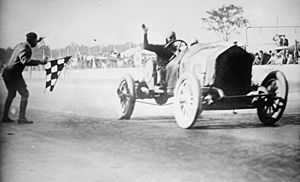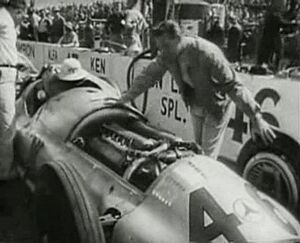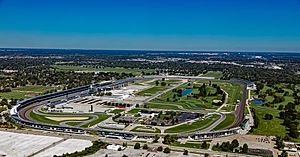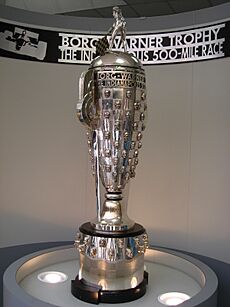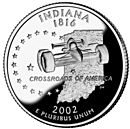Indianapolis 500 facts for kids
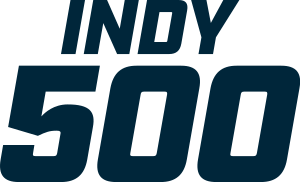 |
|
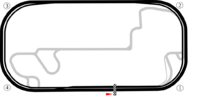 |
|
| IndyCar Series | |
|---|---|
| Venue | Indianapolis Motor Speedway |
| Location | Speedway, Indiana, U.S. |
| Corporate sponsor | PennGrade Motor Oil (2016–2018) Gainbridge Insurance Agency (2019–present) |
| First race | 1911 |
| First IndyCar race | 1996 |
| Distance | 500 miles (805 km) |
| Laps | 200 |
| Previous names | 500-Mile International Sweepstakes (1911–1915, 1920–1941, 1946–1980) 300-Mile International Sweepstakes (1916) Liberty Sweepstakes (1919) |
| Most wins (driver) | A. J. Foyt (4) Al Unser (4) Rick Mears (4) Hélio Castroneves (4) |
| Most wins (team) | Penske (20) |
| Most wins (manufacturer) | Chassis: Dallara (26) Engine: Offenhauser (27) Tires: Firestone (76) |
| Circuit information | |
| Surface | Asphalt |
| Length | 2.5 mi (4.0 km) |
| Turns | 4 |
| Lap record | 37.895 sec (237.498 mph; 382.182 km/h) (Arie Luyendyk, Reynard/Ford-Cosworth XB, 1996) |
The Indianapolis 500, also known as the Indy 500, is a famous car race. It happens every year at the Indianapolis Motor Speedway in Speedway, Indiana, USA. This exciting event usually takes place on the last weekend of May, around Memorial Day.
The Indy 500 is a big part of the IndyCar Series. This is the top level of American open-wheel car racing, often called "Indy car racing." The track is nicknamed the "Brickyard" because it was first paved with bricks in 1909. A small section of bricks is still visible at the start/finish line.
Many people call the Indy 500 The Greatest Spectacle in Racing. It's considered one of the three most important races in the world, along with the 24 Hours of Le Mans and the Monaco Grand Prix.
The very first race was in 1911, and Ray Harroun won it. The race celebrated its 100th anniversary in 2011. The 100th actual race was held in 2016. The race was paused twice: during World War I (1917–1918) and World War II (1942–1945).
Álex Palou won the race in 2025 and is the current champion. The drivers with the most wins are A. J. Foyt, Al Unser Sr., Rick Mears, and Hélio Castroneves. Each of them has won the race four times. Rick Mears holds the record for the most pole positions (starting from the very front) with six.
The Indy 500 has many special traditions. These include the 33 cars lining up in rows of three. Before the race, everyone sings "Back Home Again in Indiana." After the race, the winner drinks a bottle of milk. To qualify, drivers must complete four timed laps, not just one. The track doesn't share exact attendance numbers, but it can hold over 235,000 people in seats. With people in the infield, the crowd can reach 350,000 to 400,000!
Contents
Race History
Early Days of Racing
The Indianapolis Motor Speedway was built in 1909. It started as a gravel and tar track. Early races had problems with the track surface, causing accidents.
Because many people came to watch, the owner, Carl G. Fisher, decided to repave the track. He used 3.2 million bricks! He also added a concrete wall for safety. In 1910, the first races on the new brick track drew 60,000 fans.
The owners then decided to focus on one big race. They chose a 500 miles (800 km) distance. This was about how far a race car could go before dark. They also offered a huge prize of $25,000. This made the race very important for car racing.
The first "500" race was held on May 30, 1911. Forty cars started the race. Ray Harroun won in his Marmon Wasp car. His car had a special invention: the rear-view mirror. Harroun was the only driver without a riding mechanic, who usually helped watch for other cars. Eighty thousand people watched this first race, starting a yearly tradition.
In 1912, the prize money increased to $50,000. The number of cars was limited to 33, which is still the rule today. A riding mechanic became required. Joe Dawson won this race.
Music and Traditions
Since 1919, the Purdue All-American Marching Band has played music before the race. In 1946, singer James Melton started the tradition of singing "Back Home Again in Indiana" with the band. This tradition has continued ever since. From 1972 to 2014, actor and singer Jim Nabors famously sang the song. Since 2017, Jim Cornelison has been the regular singer.
Engine Innovations
In the 1920s, engine sizes were limited. Gaston Chevrolet won the 1920 race with the first eight-cylinder engine. In 1923, riding mechanics were no longer required. In 1925, Pete DePaolo was the first to win with an average speed over 100 mph (160 km/h).
Engineer Harry Miller built powerful engines. His engines, and later the famous 4-cylinder Offenhauser or "Offy" engine, dominated the race. The "Offy" engine won a record 27 times. It won for 18 years in a row between 1947 and 1964.
European Cars and Formula One
European car makers returned to the Indy 500 before World War II. Maserati cars helped Wilbur Shaw win in 1939 and 1940. These are the only wins for fully Italian cars.
From 1950 to 1960, the Indy 500 was part of the World Drivers' Championship. However, few F1 drivers raced at Indy. Alberto Ascari was the only European-based driver to race in the 500 during these years, driving a Ferrari in 1952.
After the Indy 500 left the F1 calendar, European teams returned. In 1963, Colin Chapman brought his Team Lotus to Indy. Jim Clark finished second in 1963 and won in 1965. This win also broke the long winning streak of the Offy engine. It was the first win for the 4.2-liter Ford V8 engine. The next year, 1966, Graham Hill won in a Lola-Ford.
The Offenhauser engine also won with McLaren cars three times. The last time the Offy engine won was in 1976. By the late 1970s, European technology took over. Most chassis and engines were European.
The most recent active Formula One driver to race in the Indy 500 was Fernando Alonso in 2017.
Modern Era and Changes

After foreign cars became common, foreign drivers also started racing regularly. Drivers like Emerson Fittipaldi (Brazil), Teo Fabi (Italy), and Arie Luyendyk (Netherlands) had good results. In 1993, Nigel Mansell, a Formula One World Champion, came to race in CART. He finished third in the Indy 500 and won the CART championship that year.
The "Centennial Era" celebrated the track's 100th anniversary (1909) and the first Indy 500 (1911). In 2009, tickets used the old name "93rd 500 Mile International Sweepstakes."
In 2014, a road course race was added to the Indy 500 weekend for the first time. In 2016, the race celebrated its 100th running with about 350,000 people attending.
In 2020, the race was delayed from May to August because of the COVID-19 pandemic. There were no fans in attendance that year. In 2024, the race was delayed for over four hours due to heavy rain.
Race Name History
The race was first called the "International 500-Mile Sweepstakes Race" from 1911 to 1916. But people quickly started calling it the "Indianapolis 500" or "the 500." In 1919, it was called the "Liberty Sweepstakes." From 1920 to 1980, it officially went back to "International Sweepstakes."
After World War II, it was commonly known as "The 500" or "Indy 500." By the late 20th century, "Indy 500" became the most popular name. Since 2016, the official race logo uses "Indy 500."
In 1981, the name "65th Indianapolis 500-Mile Race" was officially adopted. The "Sweepstakes" part was dropped.
For almost 100 years, the race did not have a main sponsor. This was unusual for a big sports event. This tradition ended in 2016 when PennGrade became the first presenting sponsor.
The Borg-Warner Trophy, given to winners since 1936, calls the event the "Indianapolis 500-Mile Race."
Race Details
The Indianapolis 500 is held at the Indianapolis Motor Speedway. This is a 2.5-mile (4 km) oval track. The track is shaped like a rounded rectangle with four turns.
Traditionally, 33 cars start the race. They line up in eleven rows of three cars. Drivers race 200 laps counter-clockwise, covering 500 miles (800 km). The race has always been held around Memorial Day since 1911. Since 1974, it's been on the Sunday of Memorial Day weekend.
The Indy 500 is the most important event on the IndyCar Series calendar. It's one of the oldest and most important car races in the world. It's said to be the largest single-day sporting event globally. The Indianapolis Motor Speedway is also the world's largest sports facility by capacity. In 2011, the total prize money was over $13 million. The winner received over $2.5 million.
Unlike most sports, where major events are at the end of the season, the Indy 500 is usually early in the IndyCar Series season. It is currently the sixth race of the 17-race schedule. Because the Indy 500 is so important, some teams focus heavily on it. They might not fully focus on the championship until after Indy.
The race is not held in wet conditions because of safety. If it rains, the race is stopped until the track is dry. If more than half the race (101 laps) is completed, officials can declare the results final. If less than 101 laps are done, the race must continue later. The track does not have lights, so daylight is a factor.
The Indy 500 does not use a "green–white–checker finish" like some other races. This means the race can end under a caution flag. However, officials can stop the race with a red flag to allow for a green-flag finish. This happened in 2014, 2019, 2022, and 2023.
Race Cars
The cars used are "Indy cars." These are professional, single-seat, open-cockpit, open-wheel race cars. As of 2020, all cars use 2.2-liter V6 engines. These engines produce between 550–750 horsepower (410–560 kW). Chevrolet and Honda make the engines. Dallara is the only company that supplies the car chassis. Firestone provides all the tires.
Starting Field
The traditional 33-car starting field at Indianapolis is larger than other IndyCar races. It usually includes all full-time IndyCar Series teams (about 20–22 cars). It also has 10–15 part-time or "Indy-only" entries. These "Indy-only" teams might be extra cars from existing teams or teams that only race at Indy. The drivers often have a lot of experience in Indy car racing. Some former Indy 500 winners might only race at Indy for several years before retiring.
Car Rules
IndyCar sets the technical rules for the Indianapolis 500. These rules are generally the same as for other IndyCar races. In the past, rules at Indy sometimes differed slightly. For example, certain engines might have been allowed at Indy but not at other races. A famous example was the Ilmor-built Mercedes-Benz 500I engine used by Roger Penske in 1994.
Teams can enter two cars with the same number: a "primary" car and a "backup" car. The backup car is called the "T" car (e.g., #2 and #2T). Both cars can be practiced, but they must share the same engine. Sometimes, teams prefer their backup car if it's faster. A "T" car can also be given a new number and become a separate entry.
All cars must pass a strict technical inspection. This checks things like weight, size, and safety equipment. Cars are inspected again before and after qualifying. The post-qualifying inspection is very thorough. Cars can be fined or disqualified if they don't meet the rules.
During the race, teams can work on the car. This usually means changing tires and refueling during pit stops. Pit stops are very fast, often under ten seconds. Teams can also quickly replace damaged parts like wings. More serious repairs are allowed in the garage area since 1998. However, teams cannot change engines. Since 1933, teams cannot add oil once the race starts. Officials also set a lap limit after which cars that have left the track for repairs cannot return to the race.
Qualifying for the Race

The race has used different qualifying rules over the years. The current four-lap (ten-mile) qualifying distance started in 1920. It has been used every year since 1939.
Qualifying now happens over two days.
- Saturday: All cars get at least one chance to qualify. They can try again if there's time. The fastest twelve drivers move on to a special "shootout" session on Sunday. Drivers who qualify 13th to 30th (or 33rd if there are only 33 entries) have their spots set. Drivers who are 31st or lower go to a separate "shootout" on Sunday to decide the last three spots.
- Sunday: For drivers who were 31st or lower on Saturday, their old times are erased. They get one guaranteed attempt. The fastest three drivers (31st-33rd) get their spots. The others fail to qualify. The fastest twelve drivers from Saturday also have their times erased. They get one attempt to set positions 7-12. The top six then get one final attempt to decide pole position (1st place) and positions 2-6.
For each attempt, cars get two warm-up laps. A team member must wave a green flag to start the attempt. The team, driver, or race officials can stop the attempt at any point. If an attempt is stopped after it starts, the previous time is usually lost. Weather can often affect qualifying, leading to changes in the schedule.
Race Sanctioning
Early Race Organizers
From 1911 to 1955, the AAA organized the race. After a big accident at Le Mans in 1955, the AAA stopped organizing races. Speedway owner Tony Hulman then started USAC in 1956. USAC took over organizing the Indy 500 and other Championship races.
From 1950 to 1960, the Indianapolis 500 was part of the FIA's World Championship of Drivers (now Formula One). But few F1 drivers raced at Indy. Alberto Ascari was the only European F1 driver to race in the 500 during these years. Juan Manuel Fangio practiced in 1958 but chose not to race.
The Indy 500 stayed under USAC control. USAC eventually stopped organizing other Indy car races to focus on sprint and midget car racing. For a few years, the Indy 500 was not officially part of the CART calendar. However, CART teams and drivers still made up most of the field. By 1983, an agreement was made for the Indy 500 to be part of the CART calendar.
From 1983 to 1995, the race ran smoothly despite the CART/USAC split. They used the same cars, and CART teams were most of the Indy 500 entries.
IndyCar Series Era
In 1994, Speedway owner Tony George announced a new series called the Indy Racing League (IRL). The Indy 500 would be its main event. George wanted to lower costs and have more races on oval tracks.
In 1996, George announced that 25 of the 33 starting spots for the 1996 Indy 500 would be for top IRL drivers. CART teams decided to boycott the race. They held their own race, the U.S. 500, on the same day. Veteran Buddy Lazier won the 1996 Indy 500.
For 1997, new rules made cars less expensive. This meant IRL and CART used different cars. No CART teams entered the Indy 500 for the next three years.
In 2000, Target Chip Ganassi Racing, a CART team, decided to race at Indy. Juan Pablo Montoya dominated the race and won. In 2001, Penske Racing returned and won with Hélio Castroneves. They won again in 2002.

By 2003, many top teams like Ganassi, Penske, and Andretti Green moved to the IRL permanently. In 2008, the two series joined together. This created a single open-wheel championship called the IndyCar Series.
NASCAR and the 500
In the 1960s and early 1970s, the Indy 500 and the Coca-Cola 600 (a NASCAR race) were on different days. Some NASCAR drivers raced in both. From 1974 to 1992, the two races were on the same day and time, making it impossible to do both.
"Double Duty"
- Further information: Double Duty
From 1994 to 2014, some NASCAR drivers tried to race in both the Indy 500 and the Coca-Cola 600 on the same day. This is called "Double Duty." The Coca-Cola 600 is scheduled for the evening after the Indy 500.
After the Indy 500, drivers would take a helicopter to the airport. Then they would fly to Charlotte for the NASCAR race. John Andretti, Tony Stewart, and Robby Gordon tried this. Kyle Larson was the latest to try in 2024 and 2025. In 2001, Tony Stewart was the first and only driver to complete all 1,100 miles in both races on the same day.
In 2005, the Indy 500 start time was moved to 1 p.m. EDT. This made "Double Duty" harder. The race usually finishes in under three and a half hours.
Two drivers, Mario Andretti and A. J. Foyt, have won both the Indianapolis 500 and the Daytona 500. Foyt also won other major endurance races like the 24 Hours of Daytona and 24 Hours of Le Mans. In 2010, Chip Ganassi became the first car owner to win both the Daytona and Indianapolis 500s in the same year.
In 2010, Bruton Smith offered $20 million to any driver who could win both races on the same day. In 2011, the Indy 500 start time was moved back to 12:15 PM EDT, making "Double Duty" possible again. Kurt Busch attempted it in 2014. He finished sixth at Indy but had engine trouble in the 600.
In 2024, Kyle Larson attempted "Double Duty." He finished 18th at Indy. Due to a four-hour rain delay at Indy, he arrived late for the 600. The 600 was then stopped by rain and not restarted, so Larson could not race in it. He tried again in 2025 but crashed out of both races.
Race Culture
Memorabilia
Many people collect items related to the Indianapolis 500. The National Indy 500 Collectors Club is a group dedicated to this hobby. It was started in 1985 and helps people discuss and trade Indy 500 memorabilia.
Entertainment
The Indianapolis 500 has been featured in several movies. It has also been mentioned many times in TV shows and other media.
Milk Tradition
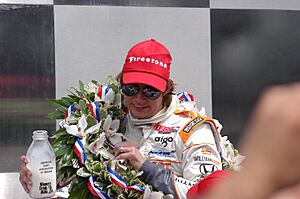
After winning his second Indy 500 in 1933, Louis Meyer asked for a glass of buttermilk. When he won his third race in 1936, he asked for milk again and got a bottle. A photographer took a picture of him drinking from the bottle and holding up three fingers. A local dairy company saw this as a great marketing chance. They offered milk to future winners.
Milk has been given to winners every year since then, except from 1947 to 1955. Today, drivers can choose whole, 2%, or skim milk.
At the 1993 Indianapolis 500, winner Emerson Fittipaldi famously drank orange juice instead of milk. He owned an orange grove. He did drink milk later, but many fans were upset. He was booed at the next race in Wisconsin, a state known for its dairy farms. Some fans continued to boo him years later.
In 2016, the track gave out 100,000 small bottles of milk to fans. This was to celebrate the 100th running of the race. Fans could toast the winner with milk.
Female Drivers

For many years, women were not allowed to participate in the Indy 500. Female reporters were not even allowed in the pit area until 1971.
Nine female drivers have qualified for the race. The first was Janet Guthrie in 1977. Sarah Fisher has raced nine times, more than any other woman. Danica Patrick has the best finish for a woman (3rd place). She is also the only woman to have led laps during the race.
Katherine Legge is the most recent woman to race (2024). She holds the fastest qualifying speeds for a woman. Her fastest one-lap speed is 231.627 mph, and her four-lap speed is 231.070 mph.
Broadcasting the Race
Radio coverage of the race began in 1922. The Indianapolis Motor Speedway Radio Network has broadcast the entire race live since 1953.
For many years, the race was not shown live on TV. This was to encourage people to attend in person. From 1964 to 1970, it was shown live in theaters. From 1971 to 1985, a recorded version was shown on ABC later the same day.
From 1986 to 2018, ABC showed the race live. However, the local Indianapolis TV station was not allowed to show it live. They had to show it later to encourage local attendance. In 2016, the race sold out, so the local station was allowed to air it live for the first time since 1950.
In 2019, the Indy 500 TV coverage moved to NBC. This was part of a new contract. The local Indianapolis NBC station still had to delay the broadcast unless the race sold out. In 2020 and 2021, the race aired live locally because there were no fans or limited fans due to the COVID-19 pandemic.
In 2022, the race could be watched live in central Indiana on the Peacock streaming service. It was still on tape delay on local TV. In 2024, the local TV blackout was lifted during the race due to rain delays.
Starting in 2025, Fox Sports will broadcast IndyCar races, including the Indy 500. On May 16, 2025, it was announced that the local blackout would be lifted for the eighth time, as a sellout was expected.
More About Indy 500
- Indianapolis 500 firsts
- Indianapolis 500 records
- Indianapolis 500 traditions
- Indianapolis 500 by year
- Indianapolis 500 pace cars
- Indianapolis 500 Rookie of the Year
- List of Indianapolis 500 winners
- List of Indianapolis 500 pole-sitters
- List of Indianapolis 500 lap leaders
- List of Indianapolis 500 broadcasters
- List of female Indianapolis 500 drivers
See also
 In Spanish: 500 Millas de Indianápolis para niños
In Spanish: 500 Millas de Indianápolis para niños


